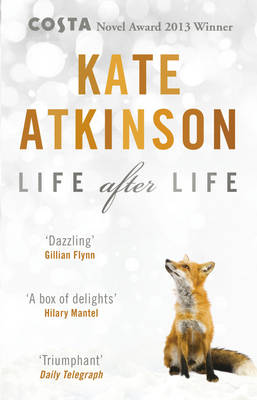Life After Life

As seen:
By Kate Atkinson
avg rating
2 reviews
During a snowstorm in England in 1910, a baby is born and dies before she can take her first breath. During a snowstorm in England in 1910, the same baby is born and lives to tell the tale. What if there were second chances? And third chances? In fact an infinite number of chances to live your life?
TweetReviews
This was an unusual novel, where the same character dies and relives the same scenes multiple times. It is tied in with both World Wars, but with particular emphasis on WWII. There are questions left unanswered at the end, but I expect this is deliberate on the part of the author to allow the reader to process the novel in the way they think best.
What if you had the chance to live your life again and again, until you got it right. This is the essential conundrum in Kate Atkinson’s 2013 novel, Life after Life.
I read this book when it first came out and enjoyed it very much. It then went the rounds of family and friends, but when I recently got it back I decided to read it again. Best decision of the month!
This, slightly paraphrased, from the resumé:
"During a snowstorm in England in 1910 a baby is born and dies before she can take her first breath.
During a snowstorm in England in 1910 the same baby is born and lives.
And so it goes on. What if there were second chances? And third chances? In fact, an infinite number of chances to live your life. Would you eventually be able to save the world – and yourself – from the inevitable destiny. And would you even want to?"
The baby is Ursula Todd, who grows up, lives, then dies, is born again, lives a little longer, dies, is born again and so on ad infinitum. During her many lives she experiences joys and tragedies, both personal and global.
In a postscript to the book Kate Atkinson talks about what made her write this book, namely the history of her family in the early 20th century closely intertwined with the history of England in that same period. And she talks about how she, like so many of us, have always been fascinated by the ‘What if?’ scenario. What if Hitler died as a baby or was shot before he came to power? Would it have made a difference? What if Sarajevo had never happened? And the many other ‘What ifs’ in our lives.
Although the central part of the story is Ursula living through the Blitz in one life, and through the last days of the Reich as the wife of a German citizen in another – both chapters more than a little harrowing – there is more to the book than that. For it begins again and again in those idyllic days before WWI and it seems to me that it is that return which anchors the story, makes it hang together and gives it its weight.
I am finding this book very difficult to describe. It is far too long and complicated for me to go into any details about Ursula’s many lives. Suffice to say that it is gripping, harrowing, joyful and utterly unputdownable.
When it first came out it received many rave reviews from eminent writers around the country, and around the world.
I expect many of you have read it already. But if not, I strongly recommend it. Even at 600 pages It is worth it. I can’t give it anything less than 5 stars.
Review by: Freyja






